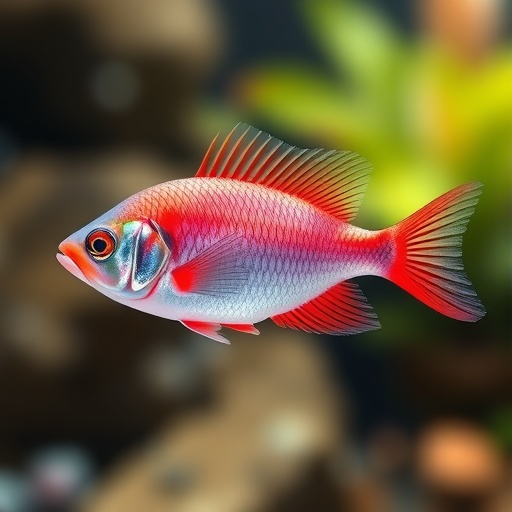In the intricate world of aquatic biology, the interplay between genetics and environmental factors takes center stage in the study of the pejerrey fish, scientifically known as Odontesthes bonariensis. Recent research led by a team of experts including Wu, Baba, and Nakagawa sheds light on the complex phenomenon of genotype-by-environment interactions during gonadal sex differentiation in this remarkable species. The implications of their findings not only advance our understanding of fish biology but also paint a broader picture of environmental influences on genetic expression.
The pejerrey fish is particularly notable because it presents an exceptional case of dual mechanisms for sex determination. Unlike species with strictly defined male or female roles, Odontesthes bonariensis exhibits both genetic and environmental pathways to develop into either sex. This duality raises intriguing questions about the evolutionary advantages of such a system and how it may buffer the species against changing environmental conditions, such as temperature and salinity variations.
The research conducted by Wu and colleagues delves into the intricate molecular pathways that govern sex differentiation. By focusing on gene expression changes in response to different environmental stimuli, the researchers were able to elucidate how external factors can trigger or suppress specific genetic programs. The concept of genotype-by-environment interaction suggests that the same genetic makeup can lead to different developmental outcomes depending on the conditions faced by the organism, a finding that underscores the complexity of evolutionary adaptation.
One of the critical aspects of the study was the identification of key genes involved in sex differentiation. By utilizing advanced genetic sequencing techniques, the research team mapped out the intricate networks of genes responsible for gonadal development in pejerrey. This genetic blueprint serves as a foundational step for further studies aiming to dissect the underlying mechanisms that facilitate these remarkable adaptations.
Moreover, the research highlights the potential for conflict resolution during the sex differentiation process. In species with mixed sex determination systems, the competition between genetic and environmental signals can lead to confusion in developmental pathways. The team’s findings suggest that regulatory networks exist to resolve these conflicts, ensuring that the fish can develop successfully into an appropriate sex based on current environmental conditions, thereby optimizing its chances of reproductive success.
The implications of this research extend beyond the realm of ichthyology. Understanding how organisms manage genetic and environmental influences can inform conservation strategies for species facing climate change and habitat loss. With ecosystems constantly in flux, species like the pejerrey may serve as valuable models for studying resilience and adaptability in the face of environmental stressors.
In addition, the study presents opportunities for applied biology, particularly in aquaculture. Insights into the sex differentiation mechanisms of pejerrey could lead to more efficient breeding programs aimed at optimizing yields based on market demands. Capturing the nuances of how environmental conditions affect sex outcomes can empower aquaculturists to manipulate breeding practices, thereby maximizing both productivity and sustainability.
The relevance of the findings also extends to ecological management. As populations adapt to shifting environmental parameters, understanding the genetic basis of these adaptations can guide interventions aimed at preserving biodiversity. By identifying species like Odontesthes bonariensis, which possess robust resilience traits, we can devise strategies to protect vulnerable species from the impacts of climate change.
While the research brings forward exciting possibilities for various fields, it also raises new questions. For instance, how do these findings translate to other species with similar dual-sex determination mechanisms? Furthermore, as environmental pressures continue to mount, will these genetic pathways hold steady, or will they evolve in unexpected ways? Such questions remain ripe for exploration, promising a wealth of future studies that continue to unravel the depths of genetic and environmental interplay in aquatic organisms.
In essence, Wu et al.’s study represents a significant contribution to our understanding of sex differentiation in pejerrey, illustrating how complex interactions between genotype and environment can shape developmental trajectories. As researchers continue to dissect these processes, we gain not only insights into the biology of fish but broader lessons about evolution and adaptation in our changing world. The findings herald an exciting era of research that emphasizes the importance of integrative approaches in biological science, paving the way for innovative solutions to contemporary environmental challenges.
As we delve deeper into the significance of the study, it becomes clear that the implications for reproductive biology are profound. The ability of species like pejerrey to navigate their development amid conflicting genetic and environmental signals is a thrilling concept that may offer clues to understanding human sex differentiation as well. The principle of adaptability witnessed in these fish could be mirrored in other species, revealing fundamental truths about biology that span across the animal kingdom.
To conclude, the exploration of genotype-by-environment interactions in gonadal sex differentiation offers a fascinating glimpse into the complexities of fish biology and evolutionary science. The findings not only enhance our understanding of pejerrey but also serve as a critical reminder of the importance of resilience in nature. As ongoing climate change continues to pose a threat to biodiversity, studies like this illuminate the intricate balance organisms must maintain in the face of environmental fluctuations, ultimately driving home the need for proactive conservation efforts.
Subject of Research: Gonadal sex differentiation in the pejerrey fish, Odontesthes bonariensis, with a focus on genotype-by-environment interactions.
Article Title: Genotype-by-environment interactive effects and conflict solving during gonadal sex differentiation of pejerrey Odontesthes bonariensis, a fish with dual genotypic/environmental sex determination.
Article References: Wu, C., Baba, W., Nakagawa, R. et al. Genotype-by-environment interactive effects and conflict solving during gonadal sex differentiation of pejerrey Odontesthes bonariensis, a fish with dual genotypic/environmental sex determination. Biol Sex Differ 16, 79 (2025). DOI: 10.1186/s13293-025-00768-7
Image Credits: AI Generated
DOI: https://doi.org/10.1186/s13293-025-00768-7
Keywords: genotype-by-environment interaction, sex differentiation, pejerrey fish, Odontesthes bonariensis, environmental influences, genetic adaptation, aquaculture, biodiversity, resilience in nature.




